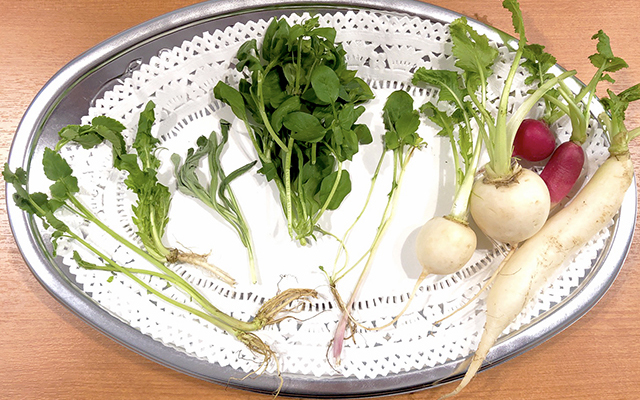- Tags:
- Healthy / Japanese folk medicine / kayu / Nanakusa-gayu / okayu / rice congee / rice gruel / rice porridge / seven herbs of Spring / Spring herbs
Related Article
-

Delicious deep-fried Japanese karaage style chicken needs no oil to make [Recipe]
-

Buy fresh salads, other tasty & healthy choices at Salad Stand vending machine in Shibuya Station
-

Best places to buy plant-based, organic and healthy food in Japan
-

Cosme Kitchen Adaptation opening in Shibuya serves tasty vegan, gluten-free and raw food
-

Veggie Donuts for the Health-Conscious: OKdoughnuts
-

Say sayonara to oily eggplants in the frying pan with Japanese farmer’s healthy lifehack



The Custom of Eating Seven Herbs of Spring
January 7th is a special day in the traditional Japanese calendar, known as Nanakusa no Sekku 七草の節句 (The Festival of the Seven Herbs). On this day, it is customary to eat a rice porridge made with seven Spring herbs. These seven specific herbs, when eaten together, are believed to bring good health and longevity.
You may consider it odd that Spring herbs are eaten at a time when icy cold winds blow and snow covers the ground but Spring begins on January 1st in the traditional Japanese calendar. It is precisely because greenery is scarce that the custom of eating young green herbs symbolizing the upcoming change of seasons was established.
The Seven Herbs of Spring
You could go out into the Japanese countryside searching for the herbs yourself, but unless you are accompanied by someone who is very knowledgeable in Japanese herbs, you may not want to take the risk of eating something you shouldn't (more about that later).
Fortunately for modern-day Japanese, the seven herbs are usually available at supermarkets in a convenient set package like this one which we found just a few minutes from our grape Japan office. Since we are in Yokohama City, we found a pack of herbs all grown locally in Kanagawa Prefecture:
Photo: © grape Japan
So then, what exactly are these seven herbs and what are their benefits?
Since it's hard to see all seven herbs clearly from that picture, we laid each one out on a tray to show them to you separately:
Photo: © grape Japan
Photo: © grape Japan
Note: All health benefits listed below do not constitute medical advice and are only provided for reference.
From left to right:
Seri
Health benefits: Seri contains beta-Carotine, Vitamins B2, C, calcium and iron. The flavonoids in seri, persicarin and isorhamnetinin have been shown to have anticoagulant properties. In Japanese folk medicine, seri is believed to increase body temperature and thus be effective in fighting chills due to the common cold. Moreover, it is also believed to be effective in regulating stomach and liver activity.
Warning: Seri is one of the few non-toxic species of the Oenanthe (water dropworts) genus, which are otherwise extremely toxic.
Nazuna
Health benefits: In Japanese folk medicine, nazuna is believed to have benefits in treating gastrointestinal and liver disorders as well as reducing eye pain and bloodshot eyes.
Gogyō
Health benefits: In Japanese folk medicine, a tea made from the dried leaves and roots of the plant was believed to be effective in stopping coughs and various ailments of the internal organs.
Hakobera
Health benefits: In Japanese folk medicine, hakobera was believed to be effective in treating bronchitis and arthritis, and to have diuretic properties.
Photo: © grape Japan
From left to right:
Hotokenoza
Health benefits: Although there are limited references in folk medicine to its use in treating high blood pressure, koonitabirako is not commonly used for its medicinal applications.
Two of the "herbs" on the right side of the plate probably looked familiar, albeit perhaps out of place since they are not typically used as "herbs": the turnip and the radish.
Suzuna
Health benefits: The Japanese turnip, kabu, is described in folk medicine as effective in regulating bowel activity, treating constipation and reducing fever.
Suzushiro
Health benefits: Radish contains the enzyme diastase which benefits digestion, as well as Isothiocyanate, the antimicrobial properties of which are helpful in warding off food poisoning.
While the white Japanese daikon radish is traditional, Western red radishes are a contemporary twist which you'll often find in such herb packages, since the red adds an appealing accent of color when cooked in a rice porridge (not to mention the auspicious combination of white and red traditionally used during the New Year season)
Into The Rice Porridge
Putting these healthy Spring herbs (and vegetables) into a rice porridge for the finished dish is quite easy.
Just washing the herbs, cut them into pieces (you can also blanch the turnip and radish in boiling water salted with a pinch of salt first for a few seconds and then dip them in ice water beforehand), set them aside and preparing your rice porridge (if you're using a Japanese rice cooker, the setting for rice porridge is probably included). Better make it more watery than thick.
Once the porridge is ready, transfer it to a casserole, add the herbs, and put the heat on high until the porridge comes to a boil once, then remove from heat. (Don't overcook the herbs).
Stir in a pinch of salt, and you're done!
Yotchan Hissatsu Shigotonin / © PIXTA
Or if you can't be bothered (and you're in Japan), you can just buy a precooked pouch of Seven-Herbs-of-Spring rice porridge to heat and eat.
However you decide to do it, taste the herbs of spring and warm yourself up with this special seasonal dish. It's definitely something to try when you visit Japan.